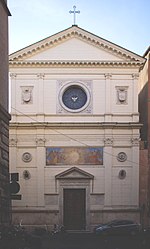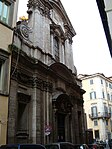Santa Maria in Monserrato degli Spagnoli

The Spanish National Church of Santiago and Montserrat, known as Church of Holy Mary in Monserrat of the Spaniards (Italian: Santa Maria in Monserrato degli Spagnoli, Spanish: Santa María de Montserrat de los Españoles, Latin: S. Mariae Hispanorum in Monte Serrato) is a Roman Catholic titulus church and National Church in Rome of Spain, dedicated to the Virgin of Montserrat. It is located in the Rione Regola, at the intersection of alleway of Via della Barchetta and the narrow Via di Monserrato, with the facade on the latter street, about three blocks northwest of the Palazzo Farnese. The last Cardinal Priest of the Titulus S. Mariae Hispanorum in Monte Serrato was Carlos Amigo Vallejo.
Excerpt from the Wikipedia article Santa Maria in Monserrato degli Spagnoli (License: CC BY-SA 3.0, Authors, Images).Santa Maria in Monserrato degli Spagnoli
Via di Monserrato, Rome Municipio Roma I
Geographical coordinates (GPS) Address External links Nearby Places Show on map
Geographical coordinates (GPS)
| Latitude | Longitude |
|---|---|
| N 41.895944444444 ° | E 12.469080555556 ° |
Address
Chiesa di Santa Maria in Monserrato degli Spagnoli
Via di Monserrato
00186 Rome, Municipio Roma I
Lazio, Italy
Open on Google Maps











